The Difference Between Cane, Rattan, Bamboo and Wicker
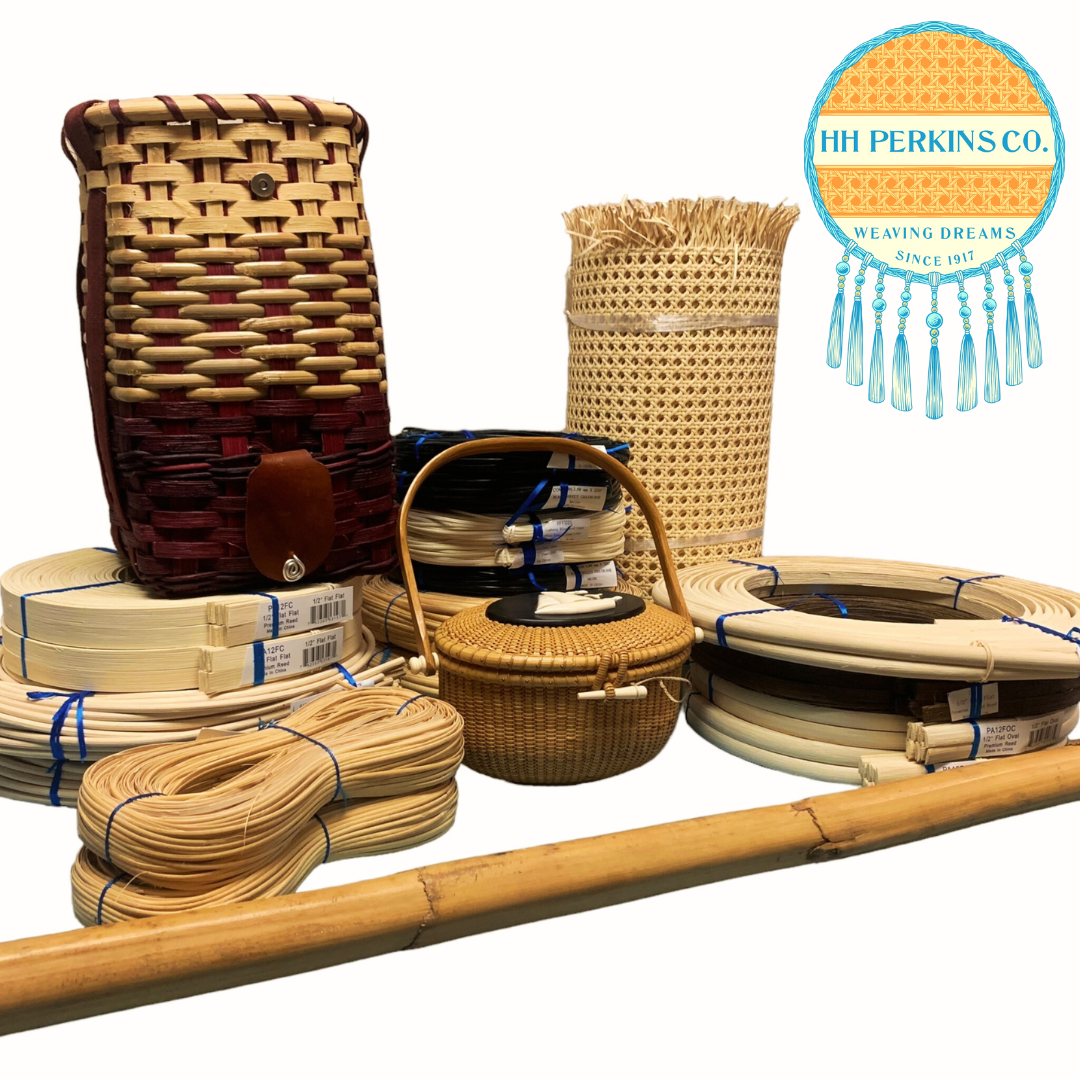
Just as Odysseus was faced with a multitude of paths, each leading to a very different fate, you stand in the HH Perkins Product Showroom, confronted with the choice between Cane, Rattan, Reeds, and Bamboo. You’ve heard the term Wicker before and perhaps even have Wicker furniture, but what is Wicker made of? Better yet, is Wicker even a material?
You've noticed these terms are often used interchangeably, but each has a nuance that can significantly influence the aesthetic and function of your space.
Cane refers to the peeled bark of the Rattan Vine, known for its glossy finish and flexibility. Rattan is the sturdy, tropical vine that gives rise to Cane, Flat Reed, Flat Oval Reeds, and Round Reeds.
Think of Rattan as the tree and the other materials as the branches. All of these materials are made from Rattan. Whether it is the peel of the Rattan Vine making Natural Strand Cane or the inner core creating your basket reeds and Reed Spline, they are all derived from the Rattan Vine.
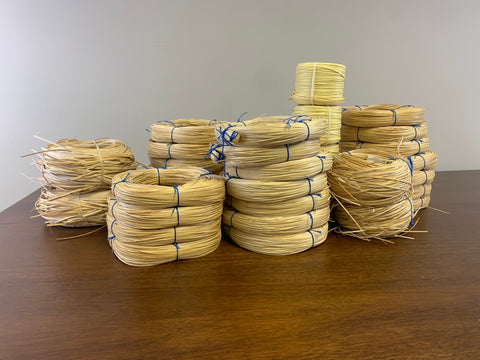
Wicker, on the other hand, is the ancient technique of weaving that can be applied to various materials but is most commonly woven with Round Reed. Wicker is not technically a material, but Round Reed is often called Wicker.
Most people know what Wicker furniture looks like. When the term Wicker is used, it describes the weaving technique used to create that furniture. Wicker is the oldest method of furniture making, dating back 5.000 years ago to Ancient Sumer!
However, it was the Ancient Egyptians who really popularized Wicker furniture. The Romans carried the torch from there, and when excavations began on Pompeii, Archaeologists found Wicker furniture and Wicker baskets still intact.
Wicker furniture is lightweight and extremely sturdy. Therefore it is an excellent choice for your deck, patio, or porch.
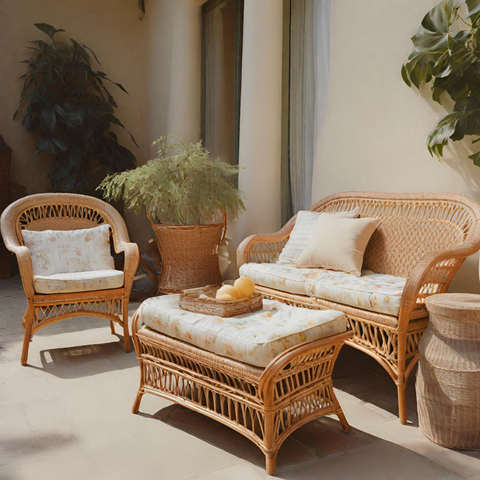
As a design enthusiast, you'll appreciate the importance of these distinctions and how they relate to sustainability and style.
By understanding their individual characteristics, you can make informed decisions about the furniture that best suits your needs.
Stay with me, and we'll explore the qualities that set each of these materials apart and how they can transform your living space into an oasis of comfort and natural beauty.
Key Takeaways
- Wicker is not technically a material. Wicker refers to the weaving method, not the material. Round Reed is the most common material used in Wicker furniture.
- Flat Reeds, Strand Cane, Flat Oval Reeds, Round Reeds, Reed Spline, and Cane Webbing derive from the Rattan Vine. The inner core of the Rattan Vine is harvested to make Reeds, while the outer bark is stripped to make Strand Cane and Cane Webbing.
- Rattan and Bamboo are similar materials but are also very different. Rattan is a solid vine, whereas Bamboo is hollow. Rattan is a flexible material perfect for basket making, crafts, and seat weaving. Bamboo is a firmer material mainly used in structures and flooring. Rattan is harvested into an array of different materials.
- Soak Cane Webbing in water for about 3 hours prior to using and install it wet. Natural Strand Cane, Reeds, and Reed Spline only need to be soaked for about 15 minutes in water.
- Cane, Rattan, Reeds, and Bamboo give a room a light and airy feeling, are eco-friendly, and require minimal upkeep. This article covers how to maintain your furniture, why these materials are so sustainable, and a conscience choice for protecting the environment.
- Natural Strand Cane and Cane Webbing are different materials. A chair with drilled holes in the perimeter must be woven with Natural Strand Cane. Cane Webbing is a pre-woven sheet installed into a channel or groove and held in place with Reed Spline. Cane Webbing can be stapled or glued into place too.
- Discover the many uses of these products and how HH Perkins’ customers use them to create stunning designs, crafts, and furniture pieces.
- The four aspects of a basket that make it a Nantucket Basket and ways to create stunning Nantucket Lightship baskets.
What is Cane, Anyway?
Cane is the slender, flexible material derived from the outer bark of the rattan vine, often used for its durability and natural aesthetic in furniture and decor.
Strand Cane is a cream color that will darken over time. You're not just choosing a chair or a shelf; you're embracing freedom in design. You can express your individuality with various cane patterns, from the tight cross-weaves to the open diamond designs.
The 7-step pattern is the most common technique for weaving chair seats. When determining the size of Strand Cane, it is important to measure the distance between the center of one hole and the center of the corresponding hole.
See the corresponding chart to ensure you choose the correct size of Cane for your project.
|
Center-to-Center Spacing |
Cane Size Needed |
|
⅜” |
SuperFine 2.0mm |
|
½” |
Fine-Fine 2.25mm |
|
⅝” |
Fine 2.5mm |
|
¾” |
Narrow Medium 2.75mm |
|
¾” (larger holes) |
Medium 3.0mm |
|
⅞” |
Common 3.5mm |
Natural Strand Cane is a favorite material for weavers because of its durability, flexibility, and timeless look that is always in style. Cane Webbing has become extremely popular in recent years too.
Cane Webbing is a pre-made cane sheet woven with Natural Strand Cane. Cane Webbing makes installation for your chair seat or cabinet much easier because you do not have to weave the material yourself.
You can purchase Cane Webbing by the 50-foot roll or by the inch. Most suppliers force customers to purchase Cane Webbing by the foot, but HH Perkins wants to cut down on waste, which is why they sell Cane Webbing by the inch.
Why should you pay for extra material you do not need? Purchasing the exact amount you need helps the environment and cuts costs. Measure the width of the piece you need, choose your style, and then type in the length you need in inches into the quantity section on the HH Perkins website.
How Do I Know if My Furniture Needs Cane Webbing?
The easiest way to know if your chair, cabinet, or furniture piece needs Cane Webbing is to inspect the piece for drilled holes. If your chair seat has holes drilled in the perimeter, it needs Natural Strand Cane.
The holes are there, so you can weave strands of cane through the holes and start making your x patterns. Weaving with Natural Strand Cane is a 7-step process.
We’ll cover that entire process in another article, but for now, it is important to distinguish when to use Strand Cane vs. Cane Webbing. Natural Strand Cane should always be paired with Binder Cane. Binder Cane covers the drilled holes in the seat and forms the perimeter of your furniture piece.
Cane Webbing is used on chairs, cabinets, and furniture pieces with a groove or channel in the perimeter. The groove in your furniture piece is where the Reed Spline is glued in, holding your Cane Webbing firmly in place. Reed Spline is glued into the channel of your chair or cabinet to hold the Cane Webbing firmly in place.

Cane Webbing should be soaked in water for about 3 hours. This will prevent your Cane Webbing from sagging after installation. Soaking your cane sheet makes it flexible and durable as you attach the Cane Webbing to your furniture piece.
Cane Webbing and Natural Strand Cane should always be installed wet. However, Natural Strand Cane should not be soaked in water nearly as long as Cane Webbing.
You should soak Natural Strand Cane for 15-20 minutes. A spray bottle or water bucket at your weaving station also comes in handy to keep your cane damp as you weave. A quick spray or applying a damp cloth keeps the Cane damp and pliable for weaving.
See how YouTube Influencer Alexandra Gater installed HH Perkins' Cane Webbing in her 4-part Home Makeover Series.
As mentioned earlier, Strand Cane is harvested from the Rattan vine. Cane is often referred to as Rattan Peel for this reason. When you get down to brass tacks, Strand Cane is actually a form of Rattan.
The inner core of the Rattan vine is what makes Flat Reed, Round Reed, Flat Oval Reed, Reed Spline, Half Round Reeds, and many other popular weaving materials.
The versatility of Cane is unmatched; it seamlessly blends with any interior style, from bohemian to minimalist to mid-century modern, making it a top design trend for those who covet a timeless yet contemporary ambiance.
Whether aiming to spruce up your home with a touch of boho charm or streamline your space with sleek accents, Cane's design trend status proves you're on the right track. Cane is very customizable. You can stain it, paint it, or pre-dye it.
HH Perkins pre-dyes Hamburg Cane so customers can add vibrant colors to their projects! Hamburg Cane is bleached white and very popular in Nantucket Basket weaving.
The versatility of Rattan products in interior design is truly impressive, and it's no wonder that their popularity is on the rise. Rattan is more than just furniture; it's a reflection of your free-spirited approach to life and a statement that you value sustainability and natural beauty in your surroundings.
Why is Cane So Popular?
You might wonder why Cane furniture has surged in popularity, and a key reason is its seamless blend of durability and aesthetic appeal.
Cane stands out with its natural, understated elegance and versatility. When considering Cane vs. Rattan Reeds, remember that Cane’s thin, sturdy makeup lends itself to intricate Cane weaving techniques that add texture and visual interest to your space.
The octagonal pattern common in dining room furniture is always woven with Strand Cane or is a pre-woven Cane Webbing sheet. You can create many different patterns when weaving with Strand Cane, and Cane Webbing has numerous pre-made designs to match the look you’re trying to achieve.
Cane furniture isn't just about looking good; it symbolizes freedom in your interior design choices. You're not just buying a piece of furniture; or materials to create your own.
You are embracing a lifestyle that values the blend of traditional craftsmanship with modern ease. The flexibility of Cane in interior design means it can adapt to your evolving tastes and settings.
Cane is used in chairs, dressers, cabinets, signs, and Cane Webbing. Cane Webbing sheets allow novice weavers to create stunning design patterns and help ease the installation tremendously.
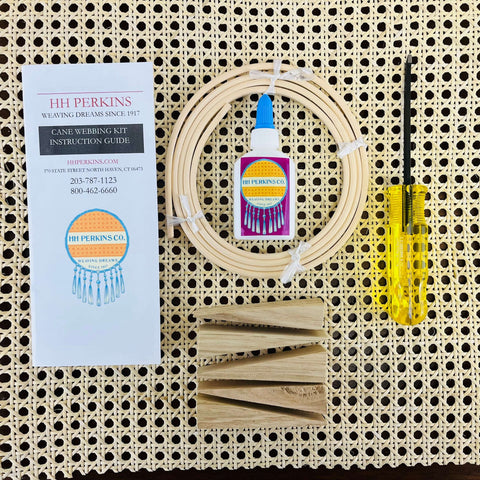
Cane Webbing looks incredible in cabinets and dressers. Fine ½” Cane Webbing, Radio Box Weave, and SuperFine ⅜” Mesh are the most popular. Cane webbing is a porous material that allows air to circulate through it, which can help prevent moisture buildup and keep the cabinet's contents dry.
This can be especially useful for cabinets that store items that are sensitive to humidity, such as clothing, linens, or electronics. Additionally, Cane Webbing can not only enhance the functionality of cabinets, but it gives them a unique and stylish look.
The intricate patterns and designs of Cane Webbing elevate the appearance of cabinets, making them a statement piece in any room. With their attractive and trendy look, cabinets with Cane Webbing are sure to catch the eye of anyone who sets foot in the room!
Nantucket Lightship Basket Weaving
Cane has also surged in popularity because of Nantucket Lightship Basket weaving. Nantucket Basket weaving originated in lighthouses off Nantucket Island.
Nantucket Basket making and Nantucket Purse creation are extremely beautiful. These intricate baskets are in museums, and they are truly special. Four aspects are necessary for a basket to be considered a Nantucket Basket.

Firstly, the basket is woven around a mold. There are different sizes and shapes of molds to make the basket of your choice.
Next, the basket staves are made of Rattan. Binder Cane is usually the top choice for basket staves. Binder Cane is created from the Rattan Peel and is wider than the Strand Cane used in seat weaving through holes.
Thirdly, the weavers on a Nantucket Basket must be woven with Strand Cane. Weavers refer to the material you are using to weave your basket. Most of the time Nantucket Basket weavers use thinner sizes of Strand Cane like Carriage Fine 1.5mm, Carriage Fine 1.75mm, or 2.0mm SuperFine.
Lastly, Nantucket Baskets must have a solid wooden base. Most Nantucket Basket Weavers use Cherry for their bases. Cherry Wood is gorgeous on a Nantucket Basket. You can then add a Cherry Handle, Cherry Rim, Bone knobs, and even Scrimshaw to your baskets. This is called basket accents.
Nantucket Basket weaving is an art form. HH Perkins carries hundreds of different products tailored explicitly for Nantucket Basket weaving, including Rims, Handles, Knobs, Washers, Bands, Stave Shavers, Mold Stands, Levelers, and so many more.
They also offer classes on Nantucket Basket weaving, so be sure to check www.hhperkins.com for the latest class schedules.
The Rattan Vine
Originating from the tropical regions of Southeast Asia, the Rattan plant is a fast-growing vine known for its sturdy yet flexible qualities, making it a preferred resource in furniture making.
The cultivation of Rattan is an art form honed over generations. Farmers tend these fast-growing palms with a keen eye, ensuring they thrive in their native jungle habitat.
This careful tending guarantees a supply of high-quality material for many uses. It is important that you choose the correct type of Rattan for your project and crafts. There are different species of the Rattan plant.
HH Perkins Co only sources the highest quality Rattan. Grown in the jungles of Indonesia, this Rattan species creates all forms of Reeds, Strand Cane, Cane Webbing, and Reed Spline.
Cane Webbing from Vietnam is a different species of Rattan. Indonesian Rattan is known for its flexibility and durability, making it an excellent choice for furniture that requires complex weaving or bending.
Additionally, Indonesian Rattan is typically a lighter color and smoother texture, while Vietnamese Rattan tends to have a darker color and a slightly rougher texture.
HH Perkins sells Rattan poles too. Customers can see what the Rattan Vine looks like with the skin of the Rattan pole still intact. Rattan Poles, or Rattan Swords as they are often called, are extremely popular in Martial Arts training, SCA, and weapons training.
The ability to bend Rattan without breaking makes it a top choice in this field. Customers steam the Rattan Poles and then bend them into all types of incredible shapes.
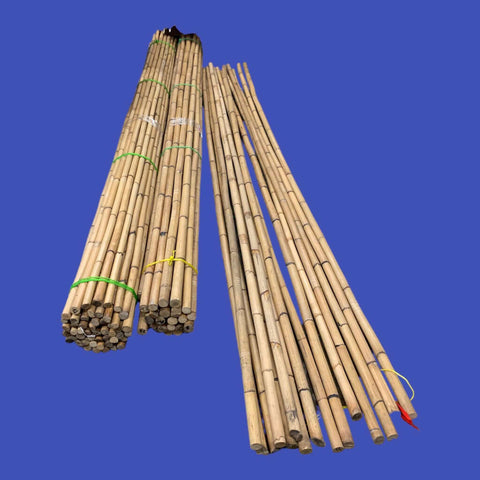
Rattan Poles can be purchased in different sizes on the HH Perkins’ website. If you are purchasing Rattan Poles to use in SCA, make sure they are 1-⅜” - 1-½”. This size is required; otherwise, the more narrow poles can go through another player's mask.
Rattan vs. Bamboo
Bamboo and Rattan are two different materials, although they are sometimes confused with each other due to their similar appearance. Bamboo is a type of grass that grows in a variety of climates, while Rattan is a type of vine that grows in tropical climates.
Bamboo is one of the fastest-growing plants in the world, making it an extremely sustainable resource. Bamboo is a sturdy, woody material that is often used for flooring, furniture, and construction. In contrast, Rattan is a flexible, fibrous material that is used for weaving furniture, baskets, and other decorative items.
While both materials are sustainable and eco-friendly, Bamboo is hollow, while Rattan is a solid vine. Bamboo has a smooth surface, while Rattan has a rougher texture due to its natural fibers. Rattan is a palm which means the stem always grows consistently. The Rattan Vine diameter is always between ¾ inches and 2 inches. Rattan is unique because it continues to grow upwards and sometimes can reach hundreds of meters long.
Rattan furniture stands as a testament to both the versatility and sustainability of this remarkable plant. It's a choice that aligns with your desire for freedom—freedom from the constraints of less eco-friendly options and the freedom to style your space with natural, organic elements. Rattan's enduring appeal in interior design is clear; it balances form and function with ease, offering durability alongside a timeless aesthetic.
When people refer to “Rattan furniture,” it is a general term that can refer to the structure of the furniture being made with solid Rattan, the seats being woven with Strand Cane or Cane Webbing, or even seats woven with Flat and Flat Oval Reeds. Remember, Rattan is the tree, and all of the other materials are its branches. All of these amazing materials are created and harvested from the Rattan Vine.
Embrace Rattan as a sustainable material. It's a renewable resource that grows much faster than timber, reducing the strain on our forests. Whether you're selecting a statement piece or outfitting an entire room, Rattan, Reed Spline, Strand Cane, Cane Webbing, Reeds, and Bamboo's lightweight yet strong nature makes them a liberating choice for your living space. Rattan invites you to break free from the ordinary and create beautiful, trendy, timeless, and responsible interiors.
Features and Application
Building on Rattan's sustainable nature, let's explore how its characteristics translate into practical applications for your home and lifestyle. Rattan's flexibility allows for a wide range of styles, from boho chic to sleek modern designs, while Cane's natural hues bring an earthy warmth to any space.
When the Rattan Vine is harvested into Reeds, the possibilities are endless. Rattan Reeds are used in seat weaving, DIY crafts, and basket weaving. In fact, the majority of baskets are woven with Flat Reeds.
Remember, Reeds are the inner core of the Rattan Vine. These Reeds are harvested into flat strips called Flat Reeds, Flat Oval Reeds that are flat on one side and rounded on the other, and Round Reeds.
Rattan is also harvested into Wide Binder Cane. Binder Cane is made the same way as Natural Strand Cane. It comes from peeling the skin on the Rattan Vine. Binder Cane is a wider form of Natural Strand Cane.
It is cut into long strips between 4mm and 10mm wide. Binder Cane is a wrapping material used on Porch Rockers, Stools, Rocking Chairs, and other furniture that requires materials to be wrapped.
The two most common Binder Cane weaving patterns are the Porch Weave and the Herringbone Pattern. Natural Strand Cane is woven through holes, whereas Binder Cane is a material that wraps around dowels or legs. Binder Cane can also be used in Wicker furniture.
The Wicker Weave is possible using Wide Binder Cane, however the vast majority of Wicker furniture is made with Round Reed. 6mm Wide Binder Cane is one of the most popular materials at HH Perkins. Try your hand at the Porch Weave, Herringbone Pattern, or Wicker Weave using 6mm Wide Binder Cane.
Many people use the term Wicker when referencing Round Reed, but as mentioned, Wicker is a type of weave. Round Reed comes in various sizes for different projects.
The individual strand lengths also vary in a 1lb coil to ensure you have the length you need. The smaller sizes are excellent for twining in basket weaving, the mid-sizes are perfect for Wicker furniture, and the bigger sizes are perfect for building furniture and structures.
The Benefits of Using Cane, Rattan, and Reeds
Delving into the world of sustainable materials, Cane, Rattan, and Reeds offer significant benefits for your home's aesthetics and functionality. These materials align with eco-friendly design principles, ensuring you make a kind choice for the planet.
Imagine furniture that looks good and carries a conscience—that's the beauty of Strand Cane, Rattan, and Reeds. They grow quickly and absorb more carbon from the air than almost any other plant or vine.
The lightweight nature of these materials means you can move pieces around with ease, giving you the freedom to refresh your space whenever the mood strikes.
Whether you're lifting a chair from the dining room to the patio or rearranging a living space, you won't be held back by heavy, cumbersome furniture. You also get sentimental from these materials, knowing humanity has used them for thousands of years.
Lastly, you'll appreciate the low maintenance requirements. A quick wipe-down is often all that's needed to keep your furniture looking pristine, freeing up more of your time for what truly matters. Embrace the simplicity and enduring charm of Cane, Rattan, and Reeds in your home. Try creating these pieces yourself. You can do it!
Now that you know the materials, why not try a Wicker weave? Soak Round Reed in water to make it pliable and create the furniture and aesthetic you want for your home.
These skills are in high demand, and anyone who can create timeless furniture or repair antiques is sought after. There is nothing like making something with your own hands that will be cherished for generations to come. A timeless art that will transcend centuries.
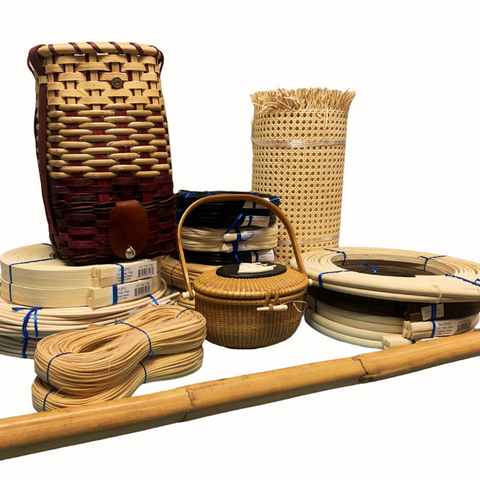
Keep it Looking Great Longer
While you're enjoying the versatility and ease of maintenance that Cane, Rattan, Reeds, and Bamboo offer, knowing how to keep these materials looking their best over time is essential. Mastering a few cleaning techniques and preventing sagging are crucial to ensuring the longevity of your pieces.
Regular dusting with a soft cloth or a vacuum with a brush attachment keeps the surfaces clean without much fuss.
To tackle the occasional spill, use a damp cloth, but avoid over-wetting, as excess moisture can lead to sagging. Eco-friendly options such as mild soap solutions can be used for a deeper clean without harming the material.
If you're into customization options, opt for removable cushion covers that can be washed or updated as you please.
Conclusion
Embrace the elegance of Strand Cane, savor the strength and structure of Rattan Poles, experiment with Reeds of all kinds, distinguish the difference between Rattan and Bamboo, and cherish the charm of Wicker furniture. You now know that Wicker is a weave and not a material. Round Reed is the most popular choice for Wicker-style weaving. These materials and weaves transform your space with their natural allure, offering sustainability, style, and sophistication.
Maintain them well, and they'll continue to weave their magic in your home, blending tradition with trend.
Remember, in the dance of design, Cane, Rattan, Reeds, Bamboo, and Wicker furniture are partners that promise to keep your interiors in step with timeless grace and eco-friendly flair.
Visit the HH Perkins website to see these products, and follow them on social media to see some of the amazing pieces people create with these products. Don’t limit yourself to one aspect; try DIY crafts, seat weaving, handicrafts, basket weaving, or even Nantucket Purse making.
The possibilities are endless. HH Perkins’ customers even make puppets, set designs, and parade floats using these simple materials. Unleash your creativity and never stop spontaneously creating!
If you want to learn more, create an account on the HH Perkins website, subscribe to emails, and stay updated with all the classes and information HH Perkins releases regularly.
After reading this comprehensive article, we hope you understand what these materials are, how to use them, and how to choose the correct product to spruce up your project and create the interior design theme of your dreams.
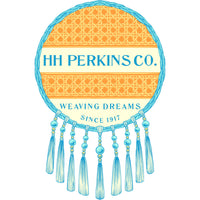











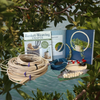
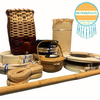
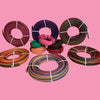
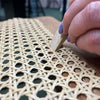
An excellent summary. Thank you.
I am still left with some questions though: For pieces of outdoor (all year long, in the north east USA) seating is wicker / rattan still suitable? Will I be able to speak to a knowledgeable person to get more information and advice?
Dear Colleagues,
I hope this message finds you well! I’m reaching out on behalf of GreenWeaver, a Vietnamese manufacturer and exporter specializing in beautifully handcrafted home décor, furniture, and accessories made from sustainable materials such as bamboo, rattan, seagrass, and water hyacinth.
Our product range includes baskets, pendant lights, furniture, trays, and other decorative items—designed to seamlessly blend traditional craftsmanship with contemporary design.
Here’s what we offer:
✅ Wholesale & OEM – Custom designs tailored to your brand
✅ Sustainable Materials – Eco-friendly and handcrafted by skilled artisans
✅ Competitive Pricing – Factory-direct from Vietnam
✅ Low MOQs & Flexible Shipping – Designed to support your business growth
We’d love to explore how our products might complement your current offerings. You can view our catalog attached, or browse our full collection here: www.greenweaverstore.com/all-products.
If you’re interested, I’d be happy to provide more details on pricing, samples, or customization options.
Looking forward to hearing from you!
Warm regards,
___________
Le Duy Dong
Sale Executive
GreenWeaver
Add: 3rd Flr, Blgd 25T2, Hoang Dao Thuy Str, Trung Hoa Wrd, Cau Giay Dist, Hanoi, Vietnam
Tel: +84 834240685
Email: dongld@vitd.com.vn
Website: www.greenweaverstore.com
Most excellent article. Makes me want to dabble in this art form more
Wicker furniture may often be round reed, but historically, willow was, and is, used for wicker work, both in Europe and North America. In Asia, rattan may have been the source for some wicker work, but willow is often sourced for wicker there too.
Having woven with both, round reed can be easier to learn on, as it can be more flexible than willow when soaked for about the same amount of time.
I disagree with your statement on bamboo. You failed to mention that bamboo makes excellent material for baskets. It is split and woven much like our native rivercane. The outer cane is excellent, strong and durable. The inner portion is similar to reed and can also be used for baskets. Bamboo has been made into baskets all over the world for thousands of years.